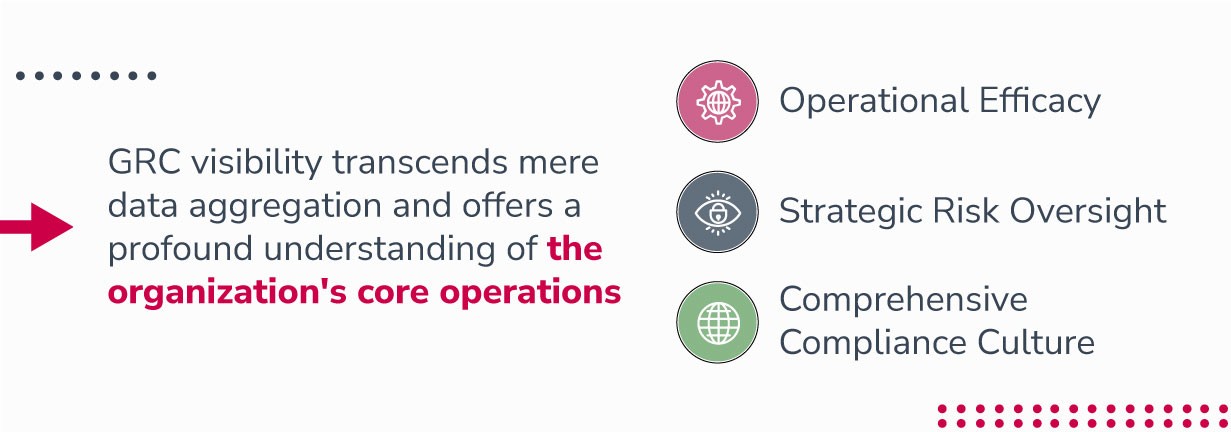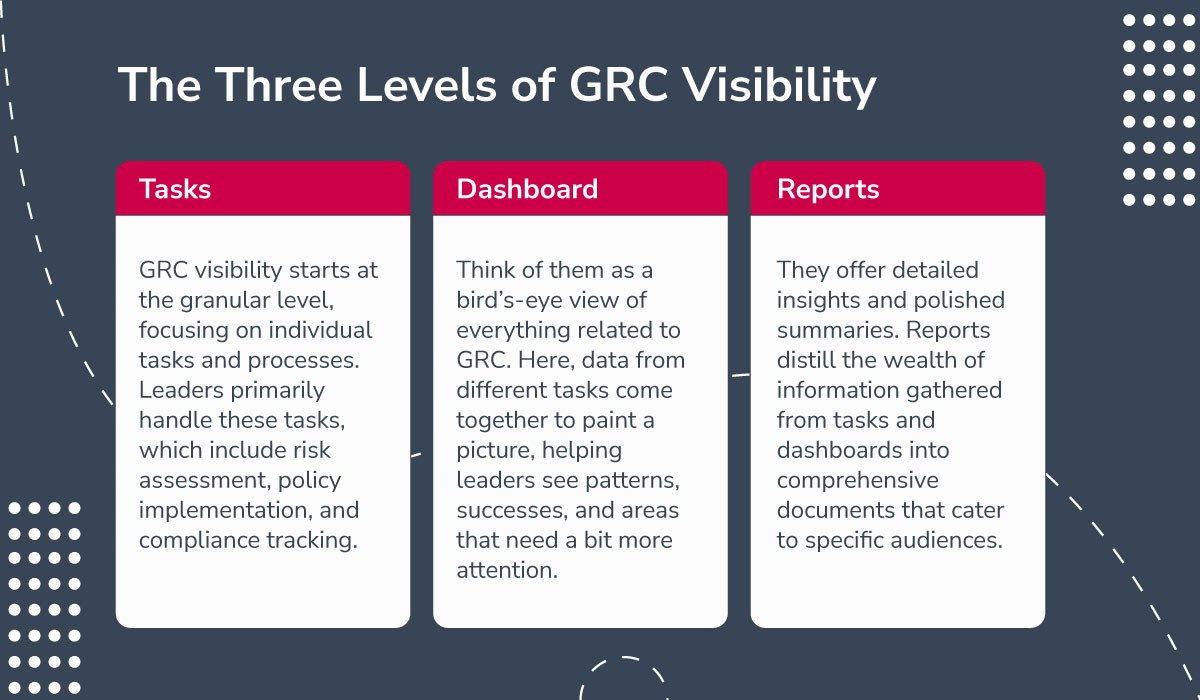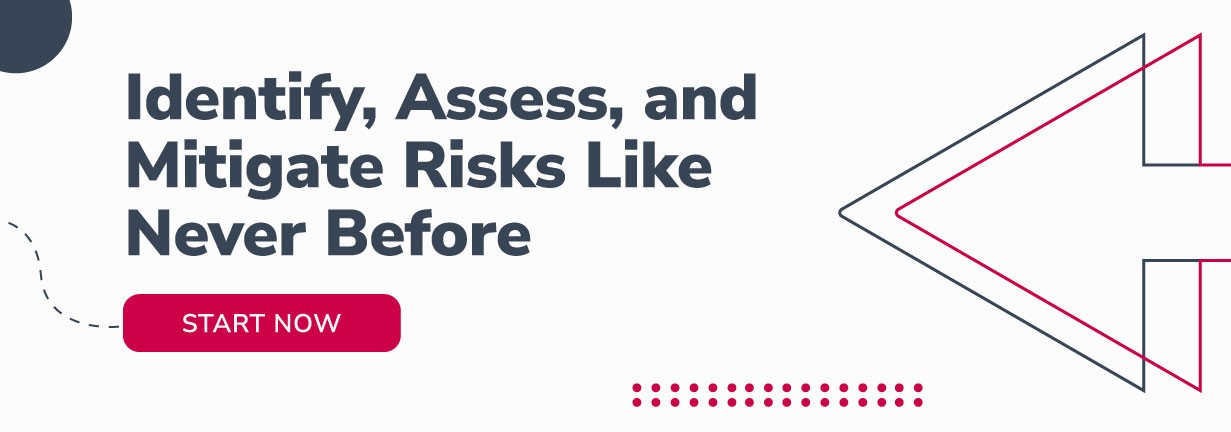Published on: Aug 31, 2023
GRC Visibility and Leadership: The Power of Informed Decision Making
In the constantly changing world of data protection, regulatory compliance, and risk control, the concept of GRC visibility has progressively become more relevant.
Although it may seem like another regular business word, it carries substantial importance in guaranteeing the comprehensive health of a company.
In this article, you'll explore the domain of GRC visibility, its essential elements, and its impact on effective decision-making across the organization, particularly from the viewpoint of executives and board members.
Let's begin!
Understanding GRC Visibility
Think of GRC visibility as your organization's control panel, offering key metrics and insights to guide you through the complexities of Governance, Risk Management, and Compliance (GRC).
A strong GRC program is essential for protecting your organization and making it resilient to various challenges. Especially in today's fast-paced tech landscape with ever-changing regulations, leaders need the right tools to make sound decisions that balance growth and risk.
So, what does GRC visibility really do for you?
Simply put, it gives executives and board members the data they need to make smart, informed choices. With complete and easy-to-understand reports, leaders get a 360-degree view of the company's risks, compliance levels, and governance structure.
Why is this crucial?
Because it helps you understand the areas that may be vulnerable, estimate what the fallout could be, and suggest ways to mitigate these risks. This clarity enables executives to know where they can safely push boundaries and where they should be more cautious, guiding effective resource allocation and planning.
In essence, GRC visibility helps turn complex information into actionable insights, streamlining decision-making and boosting your organization's resilience.
Understanding the Significance of GRC Visibility to Leadership and Boards
GRC visibility functions as a crucial tool, offering leadership and boards essential insights about the organization's operational health, resilience, and strategic direction.
At the heart of GRC visibility are three pivotal components that executives and board members must be intimately familiar with:
Governance Visibility: This isn't just about recognizing internal structures and processes; it's about understanding the governance landscape comprehensively, knowing who is responsible for what, and ensuring that decision-making aligns with the broader organizational goals. Governance visibility is at the highest level of the organization,
Risk Visibility: Opportunities and threats are abundant in the dynamic business realm. For C-level executives and board members, it's about foreseeing potential challenges, understanding their implications, and crafting strategies accordingly.
Compliance Visibility: From the board's perspective, compliance is more than just meeting standards; it's about safeguarding the organization's reputation and ensuring its longevity in a landscape riddled with regulations.
In sum, GRC visibility is essential for leadership and boards, offering them the insights needed to align the organization with its mission, vision, and values.

Why Is All This Vital For Leadership and Boards?
For leadership and boards, GRC visibility transcends mere data aggregation and offers a profound understanding of the organization's core operations.
This deep insight is instrumental in various domains:
Operational Efficancy: For key stakeholders, having a consolidated perspective on governance, risk, and compliance initiatives is invaluable. It enables swift and informed decision-making, enhancing operational efficiency by eliminating redundancies and ensuring optimal resource distribution.
Strategic Risk Oversight: The board and leadership thrive on foresight. The absence of GRC visibility can result in unnoticed vulnerabilities. However, with a clear GRC overview, they can anticipate risks, leading to timely strategies and avoiding potentially severe repercussions.
Comprehensive Compliance Culture: From a leadership viewpoint, compliance embodies the organization's ethos and commitment to its stakeholders. It's not merely about following the rules. GRC visibility ensures that ethical and legal principles are incorporated into daily operations, making compliance an organic part of the enterprise's DNA.
For boards and senior executives, GRC visibility isn't an abstract concept; it's a lens that provides clarity and direction. It's instrumental in guiding the organization's trajectory.

The Three Levels of Governance, Risk, and Compliance Visibility
Tasks: Granular Level Visibility
GRC visibility starts at the granular level, focusing on individual tasks and processes. Leaders primarily handle these tasks, which include risk assessment, policy implementation, and compliance tracking. With this detailed view, leadership can allocate resources better, track progress, and wrap up tasks on time.
What is also key at this level? Subject Matter Experts (SMEs).
These individuals possess specialized knowledge and insights crucial to task completion. Their active participation enhances the accuracy and efficiency of GRC processes. SMEs bring a nuanced understanding of regulations, potential risks, and emerging threats, thereby elevating the quality of decision-making.
In essence, this level of visibility enables decision-makers to work collaboratively, aligning their efforts toward achieving GRC objectives.
Dashboards: A Higher-Level Snapshot
Moving up the ladder of GRC visibility, you'll find dashboards. Think of them as a bird's-eye view of everything related to GRC. Here, data from different tasks come together to paint a picture, helping leaders see patterns, successes, and areas that need a bit more attention. It's like having a map, showing compliance levels, potential risks, and how effective current strategies are.
Why are dashboards handy?
First, they're a communication bridge. Different departments, different teams, but one common platform. Everyone's on the same page, making sure GRC strategies are solid.
Second, dashboards facilitate a real-time understanding of the organization's risk posture, enabling proactive decision-making. As a result, stakeholders can identify trends, potential gaps, and emerging risks more efficiently.
And the best bit? Even complex data becomes simple visuals on a dashboard, making decisions not just swift but also smarter.
Reports: Detailed Insights and Polished Summaries
At the pinnacle of GRC visibility are reports, offering detailed insights and polished summaries. Reports distill the wealth of information gathered from tasks and dashboards into comprehensive documents that cater to specific audiences. These documents serve as powerful tools for decision-makers at different organizational levels.
For executive and board members, leveraging reports provides a panoramic view of the organization's GRC performance. These reports highlight key performance indicators, trends, and the alignment of GRC efforts with business objectives. Armed with this information, executives can make informed decisions that resonate with the organization's strategic direction.
And let's not forget auditors.
For them, these reports are gold. They offer an in-depth examination of processes, controls, and compliance measures. They play a vital role during audits, as they enable auditors to validate the organization's adherence to regulatory standards and identify potential vulnerabilities.
These reports not only expedite audit processes but also enhance the organization's reputation by showcasing its commitment to compliance and security.

The Role of GRC Visibility in Risk Management
Identifying and Assessing Risks with Improved Visibility
How does GRC Visibility help in Risk Identification?
At the heart of any successful risk management initiative lies the ability to identify potential risks accurately. This is where GRC visibility steps in, acting as a magnifying glass that brings the often-hidden vulnerabilities and threats to the forefront.
With evolving cyber threats and intricate compliance requirements, visibility becomes the foundation upon which risk identification is built.
GRC visibility leverages analytics and real-time monitoring to track activities across an organization's systems, processes, and data flows. This granular view provides the necessary insights to detect anomalies, unusual patterns, and potential vulnerabilities.
By harnessing the power of GRC visibility, leaders can identify risks not just on the surface but also at their very roots, enabling timely preventive measures and reducing the likelihood of detrimental events.
The Role of Visibility in Risk Assessment
Once risks are identified, the next critical step is assessing their potential impact and likelihood. This is where GRC visibility truly shines. By providing a holistic view of an organization's risk landscape, it enables risk assessors to evaluate the severity of identified risks accurately.
With data-driven insights and a comprehensive understanding of interdependencies between risks, decision-makers can prioritize risks based on their potential impact on business operations, financial stability, and reputation.
GRC visibility also facilitates the alignment of risk assessment with compliance requirements. This ensures that not only are risks evaluated considering potential financial losses but also in terms of regulatory non-compliance and reputational damage.
This multi-dimensional perspective aids in formulating risk mitigation strategies that are not only effective but also aligned with broader organizational goals.
Mitigating Potential Risks Through Efficient GRC Practices
Let's talk about the role of Visibility in Developing Risk Mitigation Strategies.
Identifying and assessing risks is only half the battle won. The true test of a robust risk management framework lies in the organization's ability to develop and implement effective risk mitigation strategies.
This is where GRC visibility once again takes center stage, guiding the creation of targeted and precise action plans.
With comprehensive visibility into the risk landscape, leaders and executives can better understand the underlying causes of risks. This empowers them to design mitigation strategies that address not only the symptoms but also the root causes.
For instance, if a vulnerability in a critical system is identified as a risk, GRC visibility can uncover the processes, access points, and user behaviours that contribute to this vulnerability. Armed with such insights, organizations can institute measures to fortify security protocols, enhance training programs, and fine-tune access controls.
Furthermore, GRC visibility facilitates the continuous monitoring of the effectiveness of risk mitigation strategies. It enables organizations to track changes in risk indicators, assess the impact of implemented measures, and adjust strategies in real time.
This adaptability ensures that risks are not just mitigated once but are consistently managed as they evolve in response to internal and external dynamics.

The Role of GRC Visibility in Compliance Management
Tracking Regulatory Changes with Real-Time Visibility
In today's ever-shifting regulatory environment, staying updated is crucial. With GRC's real-time visibility, you're no longer chasing changes but anticipating them. As new regulations arise or old ones adapt, this visibility ensures you're always in the know.
How Real-Time Visibility Helps in Tracking Regulatory Updates
Real-time visibility in GRC enables organizations to receive immediate alerts about regulatory changes that are relevant to their industry and operations. This capability provides decision-makers with the information needed to assess the impact of these changes on their current compliance posture.
Moreover, by staying informed in real-time, organizations can proactively address any necessary adjustments to policies, procedures, or controls, ensuring a proactive rather than reactive response to regulatory shifts.
The Advantage of Automated Compliance Tracking
Manual tracking of regulatory changes can be time-consuming, error-prone, and subject to oversight. Automated compliance tracking, made possible through GRC visibility tools, significantly enhances accuracy and efficiency.
These tools can scan through vast amounts of regulatory updates, extracting pertinent information and correlating it with an organization's existing compliance framework. As a result, compliance teams can focus their efforts on strategic decision-making rather than getting lost in the minutiae of regulatory texts.
Achieving Compliance and Meeting Industry Standards
Achieving and maintaining compliance is not a one-time event; it is an ongoing journey that requires diligence, vigilance, and adaptability.
Here, the importance of visibility in the compliance equation cannot be overstated.
Importance of Visibility in Ensuring Compliance
Think of visibility in GRC as your map in this compliance journey. It offers a clear snapshot of where you stand concerning various rules and standards. With this clear view, leaders can spot and address weak points, swiftly acting to mend any compliance lapses.
The benefit?
You sidestep possible violations and the penalties that come with them.
Maintaining Compliance Standards Through Visibility
Organizations often need to adhere to a multitude of industry-specific standards in addition to general regulations. GRC visibility facilitates the alignment of processes with these standards, offering insights into areas that need adjustment.
Through continuous monitoring and reporting, organizations can ensure that they not only achieve compliance initially but also sustain it over time. This is crucial in fostering trust among customers, partners, and regulatory bodies, solidifying the organization's reputation as a trustworthy entity.
Decision-Making and Visibility
The Stakeholders Involved in GRC Decision Making
The realm of GRC is expansive, encompassing various aspects of business operations, from regulatory compliance and risk assessment to policy enforcement. Consequently, GRC decisions are not solitary endeavours; instead, they involve a constellation of stakeholders from diverse areas of expertise.
These stakeholders include executives, compliance officers, risk managers, IT personnel, legal advisors, and more. Understanding the distinctive perspectives and roles of these stakeholders is essential to appreciate the multi-dimensional nature of GRC decisions.
Understanding the Key Stakeholders in GRC Decisions
Executives bring a strategic vision to the table, seeking decisions that align with the organization's overarching objectives. Compliance officers navigate the labyrinth of regulations, ensuring that the organization adheres to relevant mandates. Risk managers, with their finger on the pulse of potential threats, strive to guide decisions that balance innovation with prudence.
IT personnel translate technical intricacies into actionable insights, while legal advisors safeguard the organization's legal standing. Recognizing the synergy among these stakeholders lays the foundation for effective GRC decision-making.
The Influence of GRC Visibility on Stakeholder Decisions
GRC visibility acts as a linchpin that interconnects these stakeholders, facilitating a seamless exchange of information and insights. Stakeholders armed with a comprehensive view of GRC data can transcend their individual roles, contributing to a holistic understanding of the organization's risk profile and compliance posture.
This cross-pollination of expertise culminates in decisions that are not siloed but rather synthesized from a tapestry of knowledge. GRC visibility empowers stakeholders to collectively identify blind spots, anticipate potential disruptions, and devise strategies that cater to the broader organizational interest.
How GRC Visibility Facilitates Evidence-Based Decision-Making
In a setting where assumptions can result in setbacks, decisions backed by evidence are paramount. GRC visibility is the vanguard of this approach, offering empirical data that substantiates the rationale behind decisions.
Whether it's assessing the feasibility of a new project, evaluating the potential impact of a regulatory change, or devising a risk mitigation strategy, GRC visibility equips decision-makers with the tools to substantiate their choices. This not only fosters accountability but also empowers stakeholders to navigate the treacherous waters of business with confidence.
GRC visibility isn't just about having data at your fingertips; it's about transforming that data into actionable insights. When decision-makers across departments and hierarchies have access to comprehensive GRC visibility, their choices are empowered by a rich understanding of the bigger picture.
In conclusion, GRC visibility is the essential framework that supports the intricate workings of governance, risk management, and compliance. It offers a comprehensive view, enabling decision-makers to tackle challenges with unparalleled insight and foresight.
Wondering how to bring this level of clarity to your GRC processes? StandardFusion can help. Our platform streamlines your governance, risk, and compliance initiatives, making it easier than ever for executives and board members to make informed decisions. Don't leave your organization's future to chance, connect with our team and upgrade your GRC visibility with StandardFusion.
As organizations navigate an increasingly intricate business landscape, GRC visibility isn't just an advantage, it's a necessity. By understanding the components of GRC visibility and its far-reaching impact on decision-making, organizations can chart a course toward sustainable success in an environment where informed choices are crucial.







